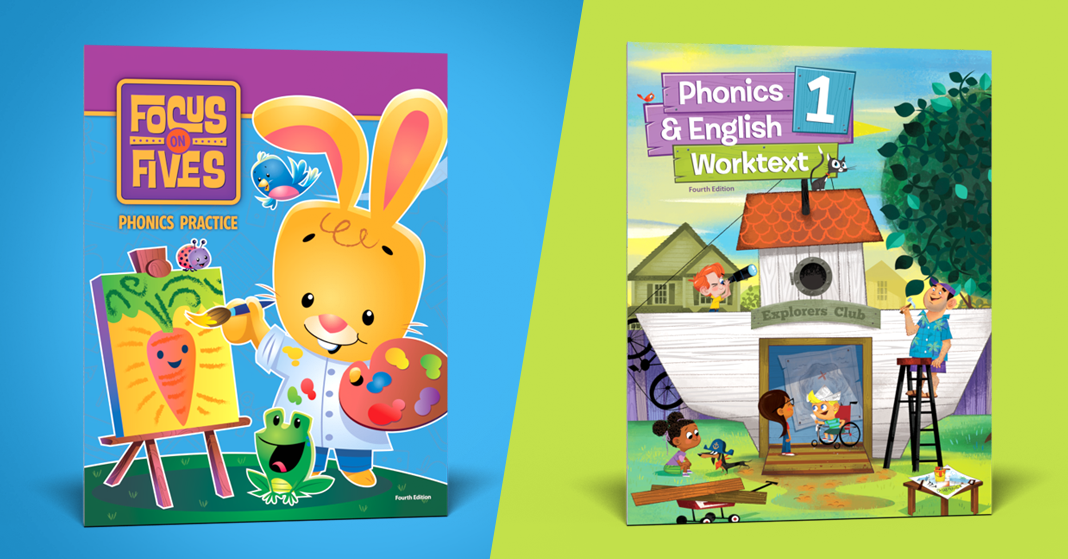 For most of us, by the time we reach adulthood, reading comes naturally. We don’t have to think about which letters make what sounds or the rules for making different sounds. We just read. But then you look at your young children who have only been talking for a short while. How do you even begin to teach them to read? Naturally, the ABCs are a great place to start, but what comes after that? What is phonics and how are you supposed to teach it?
For most of us, by the time we reach adulthood, reading comes naturally. We don’t have to think about which letters make what sounds or the rules for making different sounds. We just read. But then you look at your young children who have only been talking for a short while. How do you even begin to teach them to read? Naturally, the ABCs are a great place to start, but what comes after that? What is phonics and how are you supposed to teach it?
BJU Press’s approach to phonics in early learning and Grade 1—and even beyond to Grade 3—is fairly straightforward. If your children can talk, then they already know most of the words that they’ll be reading. You just need to give them the tools to read them.
Laying the Groundwork with Fun and Games
As a homeschool parent, you might hear a lot about sneaky learning—the idea of hiding learning opportunities in games and activities that your kids enjoy. But when your kids are just learning to read, there’s no point in hiding learning because all they do is learn, and most of the things they do are fun and games. All you need to do is direct them towards fun that will prepare them for future learning. Songs that teach rhymes, alphabet games, tracing activities, even reading to them while they look over your shoulder all help prepare your kids for the next step in learning to read. And it sets up a strong foundation to build on.
That’s why each of BJU Press’s early learning programs—Pathways for Preschool, Footsteps for Fours, and Focus on Fives—focuses heavily on activities, games, and characters that will keep children engaged and prepare them for learning.
Building Awareness
Why do you spend so much time laying the groundwork? You’re helping your children associate the sounds they hear and use to communicate with the letters and words they see on the page. It’s a big step from auditory and oral functions to visual functions.
Letter Sound Associations
Before they can read words, they’ll need to identify the sounds they hear. And that requires phonemic awareness—the ability to hear and recognize the individual sounds, or phonemes, that make up words. The s sound, the i sound, and the t sound in sit, for example. In Focus on Fives, Phonics 1, and English 1, we use numerous strategies for building phonemic awareness, including phonics stories and characters, phonics songs, rhyming songs, and read-alouds.
Manipulating Sounds
But phonemic awareness goes beyond just recognizing sounds. It’s also about being able to use and manipulate them. If your child knows the letter sounds for sit, as well as other consonant sounds, he or she can manipulate those consonant sounds into other members of the _it word family. With phonemic awareness and word families, children can learn proper pronunciation and find meaning rapidly. For children learning phonics, the words they’re starting with are usually words they already know. They need to be able to associate the letters they don’t know with the sounds they do know, so it’s less about building vocabulary and more about being able to decode sounds from letters. As they learn new sounds, they can practice combining letters and sounds into real words, and even find new words by looking for familiar patterns.
Keeping It Fun
Instead of teaching one word at a time, you’re equipping your children with the tools they need for reading all kinds of words. Tools like short and long vowels, consonant blends, r-influenced words, special vowel sounds, silent consonants, suffixes, and syllable division. Of course, most of these tools don’t have much meaning to a 5- or a 6-year-old who’s learning to read. That’s where we bring the fun back in with characters and games. Mr. Short, Miss Long, Marker E, Bossy R, and Miss Silent all give engaging visual cues that help your children learn and remember.
Reading Readiness
The goal of phonics instruction is for your children to be ready to read with comprehension and confidence. But teaching phonics alone can’t get you all the way there. Your children will also need opportunities to apply phonics principles in reading lessons. One key to that will be a phonics and reading program that supports them as they develop their skills. In Focus on Fives, we teach phonics and reading together, but in Grade 1, phonics and reading are two correlated subjects, and children practice and apply their skills separately. We continue to support phonics through Reading 3. Additionally, your children will need regular opportunities to read silently to develop reading comprehension, and to read orally to develop fluency. When children practice reading aloud, they learn to apply speaking rules (pauses, emphasis, and pacing) to their reading, adding depth and meaning. This kind of practice also improves their ability to communicate verbally.
Ultimately, you are preparing your children to read the Bible with confidence and clarity so that they can build their worldview on its principles. The way there is just one step after another. Your kids will be life-long readers before you know it!
Leave a Reply